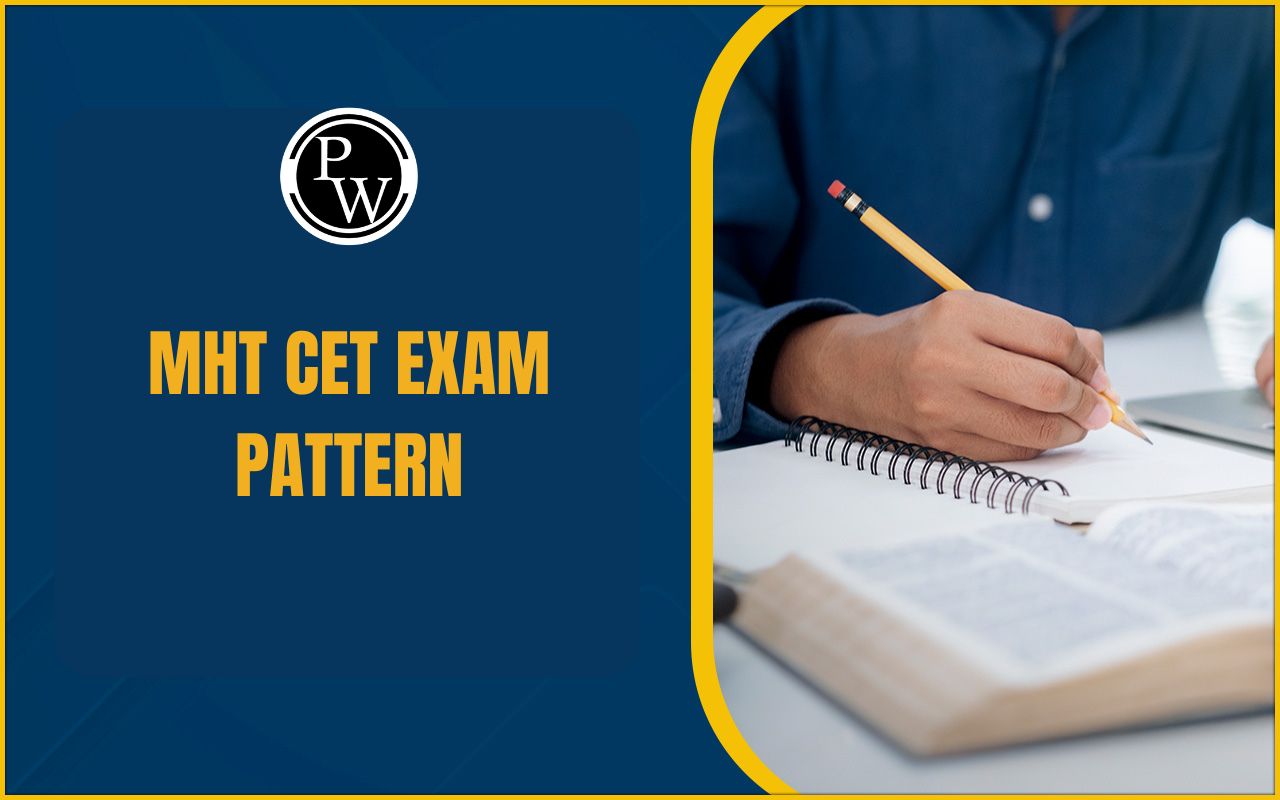
The Maharashtra HSC syllabus for 2026 includes Science, Commerce, and Arts streams and essential topics to ensure students are adequately prepared for their HSC board exams. The syllabus has been trimmed and focused on core concepts to minimize the pressure of academics on students. Most subjects are weighted approximately 70-80 marks on the theory part of the exam, with another 20-30 marks on the practical/internal assessment. Subjects in Physics, Chemistry, Biology, Mathematics, Accountancy, Economics, and Language disciplines correlate with a chapter-wise distribution as well.
The syllabus also provides a process for students to guide themselves on the important topics to focus on and practice from the previous years' examination papers to get the best results they can. Exams will be held offline and typically will take place from February - March 2026. Students will be ingrained clear conceptual understanding and application of skills.
Maharashtra HSC Syllabus 2026 Overview
The Maharashtra Board has introduced minor structural adjustments for the 2026 syllabus to simplify revision and reduce academic load. The updated PDFs clearly mention removed topics, chapter revisions and the latest marking scheme. The Maharashtra HSC Board exam is among the exams that require thorough preparation, beginning with knowing the syllabus in and out. It deals with all the streams such as Science, Commerce and Arts. Knowing the syllabus enables the students to know how to value their time, to concentrate on the main issues, and to organize their studies.
The complete syllabus is made available in PDF format which students can download directly on the official site of MSBSHSE, and so students have the benefit of having the most updated and correct version to prepare their exams.
Maharashtra HSC Syllabus 2026 Breakdown
The Maharashtra HSC syllabus 2026 comprises the subjects in three streams, namely Science, Commerce, and Arts. Every stream is subdivided into subjects and chapters to be studied. As an example, the Science stream consists of Physics, Chemistry, Biology and Mathematics. The subjects studied in Commerce include Economics, Accountancy and Business Studies, whereas the subjects studied in Arts include Political Science, History as well as Sociology.
These subject distributions help Class 12 students prioritise high-weightage chapters. For detailed PDF access, students can download stream-wise syllabus documents for Science, Commerce and Arts.
To provide the students with a clear direction in learning, the syllabus provides the topics in Class 11 and Class 12 on these subjects. This arrangement assists students in organising themselves well to pass board exams through the division of huge topics into manageable sections. It is recommended that students need to download the HSC Maharashtra board syllabus pdf because it contains the detailed content of each subject.
|
Maharashtra HSC Physics Syllabus 2026 |
|
| Chapters | Sub-topics |
| Circular motion | Angular displacement, Angular velocity, and angular acceleration, Relation between linear velocity and angular velocity, Uniform circular motion, Radial acceleration, Centripetal, and centrifugal forces, Banking of roads, Vertical circular motion due to earth’s gravitation, Equation for velocity and energy at different positions of vertical circular motion. Kinematical equations for circular motion in analogy with linear motion. |
| Gravitation | Newton’s law of gravitation, Projection of satellite, Periodic time, Statement of Kepler’s laws of motion, Binding energy and escape velocity of a satellite, Weightlessness condition in orbit, Variation of ‘g’ due to altitude, latitude, depth, and motion, Communication satellite and its uses. |
| Rotational motion | Definition of M.I., K.E. of the rotating body, Rolling motion, Physical significance of M.I., Radius of gyration, Torque, Principle of parallel and perpendicular axes, M.I. of some regular shaped bodies about specific axes, Angular momentum, and its conservation. |
| Oscillations | Explanation of periodic motion, S.H.M., Differential equation of linear S.H.M. Projection of U.C.M. on any diameter, Phase of S.H.M., K.E., and P.E. in S.H.M., Composition of two S.H.M.’s having same period and along the same line, Simple pendulum, Damped S.H.M. |
| Elasticity | General explanation of elastic property, Plasticity, Deformation, Definition of stress and strain, Hooke’s law, Poisson’s ratio, Elastic energy, Elastic constants, and their relation, Determination of ‘Y’, Behavior of metal wire under increasing load, Applications of elastic behavior of materials. |
| Surface tension | Surface tension based on molecular theory, Surface energy, Surface tension, Angle of contact, Capillarity and capillary action, Effect of impurity, and temperature on surface tension. |
| motion simple | Simple harmonic progressive waves, Reflection of transverse and longitudinal waves, Change of phase, Superposition of waves, Formation of beats, Doppler effect in sound. |
| Stationary wave study | Study of vibrations in a finite medium, Formation of stationary waves on a string, Study of vibrations of air columns, Free and Forced vibrations, Resonance. |
| Kinetic theory of gases and Radiation | Concept of an ideal gas, Assumptions of kinetic theory, Mean free path, Derivation for pressure of a gas, Degrees of freedom, Derivation of Boyle’s law, Thermodynamics- Thermal equilibrium and definition of temperature, 1st law of thermodynamics, 2nd law of thermodynamics, Heat engines and refrigerators, Qualitative idea of black body radiation, Wein’s displacement law, Greenhouse effect, Stefan’s law, Maxwell distribution, Law of equipartition of energy and application to Specific heat capacities of gases. |
| Wave theory of light | Wave theory of light, Huygens’ Principle, Construction of the plane and spherical wavefront, Wavefront and wave normal, Reflection at plane surface, Refraction at plane surface, Polarization, Polaroids, Plane polarized light, Brewster’s law, Doppler effect in light. |
| Interference and diffraction | Interference of light, Conditions for producing steady interference pattern, Young’s experiment, Analytical treatment of interference bands, Measurement of wavelength by biprism experiment, Diffraction due to single slit, Rayleigh’s criterion, Resolving power of a microscope and telescope, Difference between interference and diffraction. |
| Electrostatics | Gauss’ theorem proof and applications, Mechanical force on unit area of a charged conductor, Energy density of a medium, Dielectrics and electric polarization, Concept of condenser, Capacity of parallel plate condenser, Effect of dielectric on capacity, Energy of charged condenser, Condensers in series and parallel, van-deGraaff generator. |
| Current electricity | Kirchhoff’s law, Wheatstone’s bridge, Meter bridge, Potentiometer. |
| Magnetic effects of electric current | Ampere’s law and its applications, moving coil galvanometer, Ammeter, Voltmeter, Sensitivity of moving coil galvanometer, Cyclotron. |
| Magnetism | Circular current loop as a magnetic dipole, Magnetic dipole moment of revolving electron, Magnetization and magnetic intensity, Diamagnetism, Para magnetism, Ferromagnetism on the basis of domain theory, Curie temperature. |
| Electromagnetic inductions | Laws of electromagnetic induction, proof of, e = – dØ/dt Eddy currents, Self-induction and mutual induction, need for displacement current, Transformer, Coil rotating in uniform magnetic induction, Alternating currents, Reactance and impedance, LC oscillations (qualitative treatment only) Power in a.c circuit with resistance, inductance and capacitance, Resonant circuit, Wattless current, AC generator. |
| Electrons and photons | Photoelectric effect, Hertz and Lenard’s observations, Einstein’s equation, Particle nature of light. |
| Atoms, Molecules and Nuclei | Alpha particle scattering experiment, Rutherford’s model of atom. Bohr’s model, Hydrogen spectrum, Composition and size of nucleus, Radioactivity, Decay law, mass energy relation, mass defect, B.E. per nucleon and its variation with mass number, nuclear fission and fusion, de Broglie hypothesis, Matter waves – wave nature of particles, Wavelength of an electron, Davisson and Germer experiment, Continuous and characteristics X-rays. |
| Semiconductors | Energy bands in solids, Intrinsic and extrinsic semiconductors, P-type and Ntype semiconductor, P-N junction diode, I-V characteristics in forward and reverse bias, Rectifiers, Zener diode as a voltage regulator, Photodiode, Solar cell, I-V characteristics of LED, Transistor action and its characteristics, Transistor as an amplifier (CE mode), Transistor as a switch, Oscillators and Logic gates (OR, AND, NOT, NAND, NOR). |
| Communication systems | Elements of communication system, bandwidth of signals, bandwidth of transmission medium, need for modulation, Production and detection of an amplitude modulated wave, space communication, Propagation of electromagnetic waves in atmosphere. |
Maharashtra HSC Syllabus 2026 Mathematics
For those in the Science, Commerce, and Art paths, mathematics is an elective. The mathematics curriculum for the 12th board in Maharashtra is slightly different for students studying Science, Arts, and Commerce in 2026. Please refer to the Maharashtra Board HSC Syllabus 2026 Mathematics in the provided table.
|
Maharashtra HSC Mathematics Syllabus 2026 |
|
| Mathematical Logic | Applications of definite integral |
| Pair of straight lines | Applications of derivative |
| Matrices | Differential equation |
| Circle | Applications of definite integral |
| Trigonometric functions | Integration |
| Conics | Statistics |
| Vectors | Probability distribution |
| Linear programming problems | Bernoulli trials and Binomial distribution |
| Three-dimensional geometry | Continuity |
| Line | Differentiation |
| Plane | |
Maharashtra HSC Syllabus 2026 for Chemistry
Chemistry is a significant topic in the Science stream. One of the essential disciplines for certain engineering admission competition tests is mathematics. The subject requires diligent study and consistent practice. Please refer to the table provided for the Maharashtra HSC Syllabus 2026 for Chemistry.
|
Maharashtra HSC Chemistry Syllabus 2026 |
|
| Chapters | Sub-topics |
| Solid State | Classification of solids, unit cells in 2 & 3-dimensional lattices, calculation of density, voids, point defects, electrical and magnetic properties, Band theory of metals, conductors, semiconductors, insulators, and n-p type semiconductors. |
| Solutions and colligative properties | Types of solutions, concentration of solids in liquids, Raoult’s law elevation of boiling point, solubility of gases in liquids, solid solutions, colligative properties, depression of freezing point, osmotic pressure, determination of molecular masses using colligative properties, Van’t Hoff factor, etc. |
| Chemical thermodynamics and energetic | Work, heat, energy, First law of thermodynamics, Hess’ law of constant heat summation, extensive and intensive properties, enthalpy of bond dissociation, Second and third law of thermodynamics, etc. |
| Electrochemistry | Kohlrausch’s Law, lead accumulator, dry cell –electrolytic and galvanic cells, EMF, fuel cells, Nernst equation |
| Chemical kinetics | Activation energy, rate law and specific rate constant, Arrhenius equation, concept of collision theory, etc. |
| General principles and processes of isolation of elements | Principles and methods of extraction, reduction electrolytic method and refining |
| p-Block elements | Group 15 elements, Group 16 elements, Classification of oxides, Group 17 elements, Group 18 elements, etc. |
| d and f Block Elements | Lanthanoids, Actinoids, first row transition metals, interstitial compounds, alloy formation |
| Coordination compounds | IUPAC nomenclature, Werner’s theory, coordination number, magnetic properties, VBT, CFT. isomerism, |
| Halogen derivatives of alkanes | Haloalkanes, Haloarenes, stability of carbocations, d-l and R-S configurations. |
| Alcohols, phenols and ethers | Nomenclature, physical and chemical properties, methods of preparation, etc. |
| Aldehydes, ketones and carboxylic acids | Nomenclature, physical and chemical properties, methods of preparation, etc. |
| Organic compounds containing nitrogen | Amines, Diazonium salts, Cyanides and isocyanides, etc. |
| Biomolecules | Carbohydrates, Proteins, Vitamins, Nucleic acids, etc. |
| Polymers | Classification, methods of polymerization, copolymerization, polythene, Bakelite, nylon, polyesters, and rubber, Biodegradable, non-biodegradable polymers. |
| Chemistry in everyday life | Chemicals in medicines, Chemicals in food, cleansing agents |
Maharashtra HSC Syllabus 2026 for Biology
|
Maharashtra HSC Syllabus 2026 Biology |
|
| Chapters | Sub-topics |
| Genetics and Evolution | Genetic Basis of Inheritance, Gene- its nature, expression and regulation, RNA, Protein Synthesis. |
| Biotechnology and its application | Genetic engineering, cloning a DNA Library, Plasmids, Bacteriophages, BT crops, Biosafety Issues, etc. |
| Enhancement in Food Production | Tissue Culture, Plant Breeding, Single Cell Protein, Callus Culture, Biofortification, etc. |
| Microbes in Human Welfare | Microbes in Household food processing, Industrial Production, Biogas Production, Biocontrol Agents, Sewage Treatment, Biofertilizers, etc. |
| Plant Physiology | Photosynthesis, Respiration, Mechanism of Aerobic and Anaerobic Respiration, Fermentation, etc. |
| Reproduction in Plants | Asexual reproduction, Sexual Reproduction, Double Fertilization, Pollination, Post-fertilization changes, etc. |
| Habitat and Niche | Ecosystems, Ecological succession, Environmental issues, etc. |
| Zoology | Genetics and Evolution, Biotechnology and its Application |
| Genetics and Evolution | Origin and the Evolution of Life, Chromosomal Basis of Inheritance |
| Genetic Engineering and Genomics | DNA Fingerprinting, Genomics, Human insulin, Gene Therapy. Transgenic animals. |
| Human Health and Diseases | Immunology, Antigen-Antibody Complex, Pathogens and Parasites, Adolescence, Drug Abuse, Cancer and AIDS, etc. |
| Animal Husbandry | Dairy, Animal Breeding, Fisheries, Lac culture, Poultry, Beekeeping, Sericulture |
| Circulation | Blood composition and coagulation, Heart, Pulmonary and Systemic Circulation, Cardiac output, Regulation of cardiac activity, Blood-related disorders, ECG, Lymphatic System |
| Excretion and osmoregulation | Modes of excretion, Excretory System, Role of Kidney in Osmoregulation, Regulation of kidney function, Disorders, etc. |
| Control and Co-ordination | Nervous System, Sensory receptors, Endocrine System, Hormones and their functions, Common disorders, etc. |
| Human Reproduction | Reproductive system in male and female, Reproductive cycle, Reproductive health, Contraception and sexually transmitted diseases, etc. |
| Ecology and Environment | Biodiversity and its conservation, Population and ecological adaptations, Environmental issues, |
Maharashtra HSC Syllabus 2026 English
A student's proficiency in English grammar, reading, and writing will be assessed. The Grammar part includes predetermined subjects. Please refer to the Maharashtra HSC Syllabus 2026 English.
- Tenses
- Types of sentences
- Clauses
- Reported speech
- Prepositions
- Word formation
- Infinitives
- Gerunds and Participles
- Linking words/discourse markers
Maharashtra HSC Syllabus 2026 for Political Science
The candidates can go through the Maharashtra HSC Syllabus 2026 for Political Science which has been mentioned in the table given below. The political science includes Indian Constitution and Politics in India along with the topics.|
Maharashtra HSC Syllabus 2026 for Political Science |
|
| Part 1-Indian Constitution: Characteristics |
1. Fundamental Rights, Directive Principles, and Fundamental Duties. 2. Legislature: Parliament. Lok Sabha and Rajya Sabha, Lawmaking process, Amendment procedure State legislature: Vidhan Sabha, Vidhan Parishad 3. Executive: President – Election, Power and Functions Vice President – Election, Power and Functions Prime Minister and Council of Ministers – Election. |
| Part 2- Politics in India |
6. Patterns of Party Competition
7. Political and Social Movements
|
Maharashtra HSC Syllabus 2026 for Economics
The Maharashtra HSC Syllabus 2026 for Economics has been mentioned below for the candidates.- Introduction to Microeconomics
- Consumers behavior
- Analysis of Supply
- Types of Market & Price determination
- Factors of Production
- Introduction to Macroeconomics
- National Income
- Determinants of Aggregates
- Money
- Commercial Bank
- Central Bank
- Public Economics
Maharashtra HSC Syllabus 2026 for Sociology
The Maharashtra HSC Syllabus 2026 for Sociology has been mentioned below for the candidates.- Formation of Indian Society
- Segments of Indian Society
- Social Institutions in India
- Major Social Problems in India
- National Integration
- Social Change in India
- Social reformers in India
- Globalization and Mass Media
Maharashtra Board HSC Subjects for Arts
The Maharashtra HSC Syllabus 2026 for Arts has been mentioned below for the candidates.|
Maharashtra Board HSC Syllabus for Arts |
|
| Compulsory Subjects | Elective Subjects |
| English |
|
Maharashtra HSC Syllabus 2026 Subjects for Commerce
The Maharashtra HSC Syllabus 2026 for Commerce has been mentioned below for the candidates.|
Maharashtra HSC Syllabus 2026 Commerce |
|
| Compulsory Subjects | Elective Subjects |
| English |
|
| Modern Indian Language or Modern Foreign Language or Classical Language | |
| Environment Education | |
| Health and Physical Education Elective Subjects | |
Maharashtra Board HSC Subjects for Science
The Maharashtra HSC Syllabus 2026 for Science has been mentioned below for the candidates.|
Maharashtra Board HSC Syllabus 2026 for Science |
|
| Compulsory Subjects | Elective Subjects |
| English |
|
| Modern Indian Language or Modern Foreign Language or Classical Language | |
| Environment Education | |
| Health and Physical Education Elective Subjects | |
Maharashtra HSC Syllabus PDF Download
Students frequently search for terms like “Maharashtra state board syllabus class 12 science 2026 PDF” and “HSC syllabus 2026”. To make navigation easier, all major subject PDFs are compiled here for one-click access.
Downloading the Maharashtra HSC Syllabus PDF is crucial for every student because it serves as an official roadmap for exam preparation. The PDF allows students to keep track of all topics they need to cover and check their progress regularly. This targeted preparation technique reduces exam stress and boosts confidence. The Maharashtra state board HSC syllabus downloadable PDF is available on the official board website. Direct Links to download the subject-wise syllabus PDFs are also provided here.
| Maharashtra HSC Syllabus PDF Download | |
| Subject | PDF Download Link |
| Maharashtra HSC Physics Syllabus | Download |
| Maharashtra HSC Chemistry Syllabus | Download |
| Maharashtra HSC Biology Syllabus | Download |
| Maharashtra HSC Maths & Stats Syllabus | Download |
| Maharashtra HSC English Syllabus | Download |
| Maharashtra HSC Economics Syllabus | Download |
| Maharashtra HSC Book Keeping & Accounts Syllabus | Download |
| Maharashtra HSC Organisation of Commerce Syllabus | Download |
| Maharashtra HSC Political Science Syllabus | Download |
| Maharashtra HSC Geography Syllabus | Download |
| Maharashtra HSC History Syllabus | Download |
| Maharashtra HSC Marathi Syllabus | Download |
| Maharashtra HSC Gujarati Syllabus | Download |
| Maharashtra HSC Hindi Syllabus | Download |
| Maharashtra HSC Urdu Syllabus | Download |
| Maharashtra HSC Marathi Literature Syllabus | Download |
| Maharashtra HSC Environment Education Syllabus | Download |
| Maharashtra HSC General Knowledge Syllabus | Download |
| Maharashtra HSC Sanskrit Syllabus | Download |
| Maharashtra HSC Geology Syllabus | Download |
| Maharashtra HSC Sociology Syllabus | Download |
| Maharashtra HSC Psychology Syllabus | Download |
| Maharashtra HSC Secretarial Practice Syllabus | Download |
| Maharashtra HSC Drawing Syllabus | Download |
| Maharashtra HSC Information Tech (Science) Syllabus | Download |
| Maharashtra HSC Information Tech (Arts) Syllabus | Download |
| Maharashtra HSC Information Tech (Commerce) Syllabus | Download |
Maharashtra Class 12 Exam Pattern 2026 (Theory + Practical Marks)
1. Overview
- Total Marks per Subject: 100 Marks
- Exam Mode: Offline (Pen and Paper)
- Total Aggregate: 600 Marks (Best of 5 rule not applicable)
- Question Pattern: ~25% Objective, 75% Subjective (Short/Long Answers)
2. Science Stream Marks Distribution
|
Subject |
Theory Marks |
Practical / Internal Marks |
Total |
|
Physics |
70 |
30 (Practical Exam) |
100 |
|
Chemistry |
70 |
30 (Practical Exam) |
100 |
|
Biology |
70 |
30 (Practical Exam) |
100 |
|
Mathematics & Statistics |
80 |
20 (Practical/Journal) |
100 |
|
English |
80 |
20 (Oral Test) |
100 |
|
Bifocal (CS/Electronics) |
100 (50+50) |
100 (50+50 Practical) |
200 |
|
Information Technology (IT) |
80 (Online) |
20 (Practical) |
100 |
Export to Sheets
3. Commerce Stream Marks Distribution
|
Subject |
Theory Marks |
Internal / Project Marks |
Total |
|
Book-Keeping & Accountancy |
80 |
20 (Project/Assignment) |
100 |
|
Economics |
80 |
20 (Project/Assignment) |
100 |
|
Org. of Commerce (OCM) |
80 |
20 (Project/Assignment) |
100 |
|
Secretarial Practice (SP) |
80 |
20 (Project/Assignment) |
100 |
|
Mathematics |
80 |
20 (Practical/Journal) |
100 |
|
English |
80 |
20 (Oral Test) |
100 |
Export to Sheets
4. Arts Stream Marks Distribution
|
Subject |
Theory Marks |
Internal / Practical Marks |
Total |
|
History |
80 |
20 (Project/Internal) |
100 |
|
Political Science |
80 |
20 (Project/Internal) |
100 |
|
Sociology / Psychology |
80 |
20 (Project/Internal) |
100 |
|
Geography |
80 |
20 (Practical/Map Work) |
100 |
|
English |
80 |
20 (Oral Test) |
100 |
Export to Sheets
5. Internal Assessment Breakdown (The 20 Marks)
- Languages: 10 Marks (Orals - Listening/Speaking) + 10 Marks (Assignments).
- Theory Subjects: 20 Marks via Application Based Test (ABT) or Project + Viva.
6. Passing Criteria
- Minimum Requirement: 35% Aggregate (35 Marks out of 100).
- Note: It is recommended to score at least 28 marks in the Theory paper to ensure passing, as combined passing rules can vary by college/year regulations.
Steps to Prepare for Maharashtra HSC Exam 2026
-
Every subject listed in the Maharashtra HSC timetable 2026 pdf should be studied by students.
-
Students ought to schedule their studies appropriately and allot enough time for practice and revision.
-
Making every effort to complete the Maharashtra HSC past year question papers. Candidates will undoubtedly be able to evaluate their performance and acquire confidence from this.
-
Set aside time for Class 12 Maharashtra Board revision on a regular basis to help you retain the key information and equations for a longer period.
-
Seek guidance from educators and professionals to obtain prompt and accurate answers to challenging queries
To score above 80%, focus on repeated questions from the last five years, maintain a chapter-wise error notebook, and practice writing long-answer responses within time limits.
Maharashtra HSC Syllabus 2026 FAQs
Is Maharashtra Board syllabus reduced for 2026?
What is the passing rule for HSC 2026?
Is HSC board paper checking strict?










